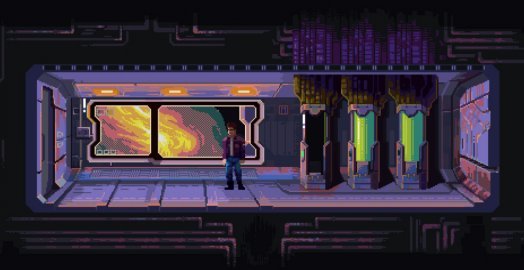Review for Tardy

Tardy is that rare breed of adventure game that takes the fundamentals of the past and twists them just slightly askew to create something different while still being wholly recognizable. Where other games go for expansive environments, Tardy reins them in. Where others provide many icon-based inventory items, Tardy offers few but makes them more directly interactive. With challenging puzzles, a solid science fiction story, and a look and sound all its own, Tardy is not shy about making an impression, albeit one that’s a little rough around the edges at times.
The game begins in media res with a conversation between two off-screen characters, one of whom is the playable protagonist, the spacefaring vagabond Ramto. Ramto accidentally stumbles into a “crio” chamber aboard the starship Wall, which renders him unconscious, only to awaken two years later to find the ship traveling through space but now seemingly abandoned and having sustained some damage. As you begin to make your way through the vessel, restoring offline systems and the like, you discover that its designer had a predilection for injecting unusual puzzles into odd places, such as the elevator controls and any computer system you may come across.
In short order you encounter Ann, the only other person on the ship, although she is cut off from you and can only speak through the comm equipment and the occasional holographic projection. Unlike Ramto, who is aboard as a stowaway, it turns out Ann is actually part of the crew. As the story unfolds, it becomes clear that something bad happened here, with various crew members having perished in grisly fashion. You’ll also learn that the ship was headed for the Imperial planet Vironia to help fortify it against the robotic armies of the Confederacy. Ann in particular is eager to get there to help her trapped sister. Ramto, meanwhile, doesn’t consider himself a hero and doesn’t want to go anywhere near the fighting. Either way, the ship is in a bad state and the pair must limp to a nearby planet to scavenge parts before any long-term plans can be made.
Tardy has no shortage of standard sci-fi themes, including a galaxy divided between two major factions (the Empire and the Confederacy), faster-than-light star travel, colonization of planets, robot armies, and even experiments in time manipulation. Yet some of these ideas have been subtly shifted from the usual clichés in welcome ways, with Ramto and Ann’s differing points of view on various topics making such concepts even more interesting. To reveal too much would spoil surprises best experienced for yourself, but along with what you discover through the two protagonists’ conversations, the sometimes borderline paranoia expressed through various journals and news stories scattered around makes for quite a compelling experience.
Even with all its world building, Tardy’s story focuses most on the human element. Ramto and Ann reveal glimpses into themselves as well as their circumstances through their often sarcastic banter. As you proceed, they do begin to bond and come to identify with one another, although it would be a stretch to say they ever really become BFFs. Their frequent bickering about obstacles can wear a little thin at times, but they take great delight in continually pointing out the absurdity of the Wall designer’s penchant for puzzles, and there are even some heartfelt moments that avoid getting too sentimental.
The game looks, sounds, and plays much like a retro 2D point-and-click adventure, but again with some interesting differences. Visually, Tardy has a very unique style with all locations, whether ship- or planet-based, being drawn in various pastel shades, primarily blues and pinks. It’s a very appealing pixel art look that makes Ramto’s solitary journey – save for Ann’s voice – feel all the more melancholy. Most areas you visit also incorporate a number of background animations. Whether it’s the sight of a nebula slowly drifting past the windows of the Wall, or an abandoned dog following you around on a planet’s surface, these ambient touches all add to the reality of the game world.
The sad, decayed feel of this universe is helped along by Tardy’s synth score. Very reminiscent of the first Blade Runner movie, each scene in the game has its own low-key tune running in the background. Only in a couple of places did I find some of the track loops beginning to grate, although that may have been due to getting stuck for a time in those areas and becoming more conscious of the music as I tried to come up with new ideas to solve puzzles. All in all, the soundtrack is quite fitting for the atmosphere being projected.
On the control front, you guide Ramto about in normal fashion, clicking where you want him to walk. However, instead of having a wide array of hotspots hidden in each environment, here you will find just a small number – usually two or three to start with – of white exclamation points bobbing in the air. Clicking on these will cause Ramto to interact with their related areas in a context-specific fashion. For example, the one for a hologram of Ann will allow Ramto talk to her, while the one for a computer display will cause a close-up of that computer to appear over the main scene. As you interact with the initial hotspots, more will sometimes become unlocked.
Unlike most adventures that give you multiple scenes to travel through at a time, in Tardy you will only ever be able to access one scene at any given moment. Once you’ve completed all the tasks in the immediate vicinity, you’ll move onto another scenario with its own set of hotspots. It’s highly streamlined, but there’s something quite satisfying in knowing that the pieces you need to solve the challenges before you are all currently available. This extends to inventory items too, as once you leave one location any objects you’ve accumulated to that point are taken away.
The inventory items themselves function differently from other adventures. When you click on hotspots, you are typically taken to a close-up view of some piece of machinery or a display that you need to interact with. These frequently have things like journals or portable pieces of equipment that you can take. Instead of becoming small representational icons in some inventory bar, however, here the life-sized items are displayed as long as you’re in that environment. You will need to click and drag these new possessions into the generous black margins around the current view screen in order to organize them in such a way that you can continue adventuring. In some cases you need to drag items to specific areas of the scene, such as a flashlight needed to reveal important information hidden in a darkened shaft, or when you overlay a piece of paper with holes cut in it onto a page of numbers to reveal a secret code.
The direct use and manipulation of these acquired objects is quite compelling, feeling very similar to the paperwork in Papers, Please. Fortunately, unlike that game, Tardy provides plenty of screen real estate to place the various items where they’re all easily accessible without getting in the way of each other or the active scene at hand. These objects and the various close-up devices and displays you encounter form the bulk of the game’s obstacles.
The puzzles here are quite challenging, mostly because they provide very little direction or feedback. In many instances you are given a brief description of what needs to be accomplished and are then left to sort out the steps yourself. This can sometimes be a bit frustrating, as the characters will offer information that doesn’t really make sense until you’ve had a chance to see the puzzle. If you’re not paying close attention to what the protagonists say, you may miss something important and have no way of going back to hear it again. Ordinarily I’m not a fan of this tactic for making games harder but here it works well, probably due to the constrained single-scene environments with limited hotspots.
While certainly making you think, the puzzles are generally fair. Most of what you encounter are machine manipulation puzzles of one sort or another. There are familiar standbys like rotating sections of pipes to make electrical paths, made harder by viewing only a portion of the pipes at a time through the small lenses of high tech x-ray specs. There are also more unique tasks, like having to determine the combinations to pairs of locks when you can only make out the digits on one lock in each pair.
There was only one puzzle I had to look up online after flailing about for nearly an hour. Unfortunately, it’s one of the first ones you deal with in the game, which involves finding a name and password to log into a computer. Locating these individually isn’t too difficult, but the password belongs to a character that does not match the name of the person you need to unlock the computer. I saw no logical connection why these two would be used together. The computer offers no help in this situation, as attempting an incorrect combination merely results in the generic message “wrong password or login” being displayed.
Towards the end of the game I also struggled with a second scenario, where the goal as stated was to essentially overload a circuit breaker by running a bunch of different machines, each of which adds a different strain to the electrical system. (For some reason, activating everything possible does not overload the circuit.) I eventually solved the puzzle by trial and error, working through each combination of equipment until I found the correct one. Even after completing it, I’m still uncertain as to why the correct sequence actually worked. In any case, these two puzzles are the weaker exceptions in an otherwise strong offering of challenges.
And then there are the arcade games. At several points during your journey, you must beat various minigames to proceed. The first is Pong, later followed by Space Invaders, for which you must pass a single wave of aliens. The final game is a version of Galaga. While the alien enemies here move in simpler ways than in the actual game, the added challenge is in having to play in two-player mode and successfully guide both players’ ships past the swarming space enemies. If either player loses all their lives, you must attempt the sequence again.
Although these arcade sequences can be played by clicking on-screen buttons with the mouse, I found the alternate keyboard controls far easier to use. In fact, I wish the keyboard was utilized in more areas. At various points you have to use computer systems that are driven by simple command prompt instructions such as “login”, “help”, and “coords”. The problem is that you cannot use your actual keyboard but instead must type in the commands one letter at a time by clicking on a virtual version of one. This became particularly annoying during the login puzzle, as for each attempt you must laboriously type “login”, then the name you want to try, then the password. This really slows down your ability to try different combinations to find the right solution.
Tardy took me a little over four hours, although play time may vary more than most adventure games depending on how quickly inspiration strikes in solving puzzles. Even so, this probably isn’t a game you’ll finish in one sitting, as you may need a break to mentally recharge between objectives. Just be sure if you do step away that you finish your scene first. The game lacks a proper save system, relying on a checkpoint method instead, with your progress recorded only after completing the current area. Consequently, if you’re in the midst of solving a puzzle and choose to quit, you will have to replay from the start of that level when you return. Most locations comprise one or two major puzzles, usually with smaller steps along the way, so the checkpoints don’t require too much repetition, but it is something to be aware of.
Also of note is the game’s localization. Tardy was developed by the Belarussian team One Wing Cicada, whose first attempt to translate the game into English isn’t the greatest. (A fact that, to their credit, they’ve noted in a post on their Steam forum and are seeking help to improve.) Dialog is presented entirely in text, so there are no voice problems to deal with. At the time I played, the most glaring issues were awkward sentence structures and odd vocabulary choices. Even so, it’s a testament to the game’s story and characters that they rise above these difficulties and remain compelling throughout.
I really enjoyed Tardy for the most part. Despite a couple overly obscure puzzles and the work-in-progress localization, I found this to be a really solid adventure with a good science fiction story at its core. Making inventory items more tangibly interactive and condensing play into individual scenes results in the game feeling both familiar and yet refreshingly new at the same time. The developer’s commitment to continue improving the game is also heartening to see (they’ve indicated they’re also working on a way to improve the login puzzle), so the experience can only get better from here. If you’re a fan of science fiction or challenging adventure game puzzles, you should definitely consider Tardy.






























